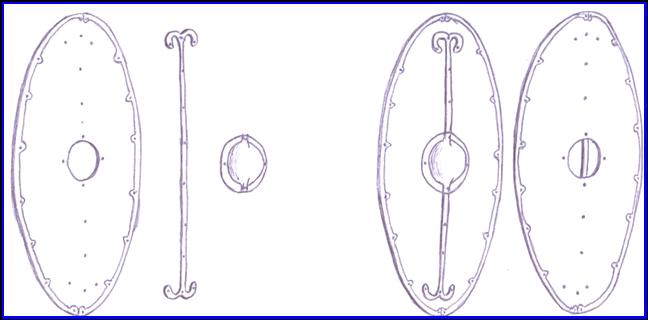|
The remains of iron 'shield handles' or 'reinforcing
strips' (figure A) are well known from a number of first century
Roman military sites. These are sometimes fairly plain but many
feature bifurcated ends. These reinforcements have been interpreted
in various ways, with some authors assuming a horizontal placement
to facilitate a horizontal handle and others preferring a vertical
position which dictates a vertical handle but which provides longitudinal
reinforcement. Usually it seems to be assumed that these pieces
were attached to the backs of shields. Certainly this may have
been the case with the ones which are known to have measured two
feet or less in length and these may well have formed horizontal
handles. However, there are good grounds for believing that some
of the longer ones (which would have been too long to fit horizontally
across a shield) may actually have been placed vertically on the
faces of shields.
Amongst the shield covers (tegimen) from
Vindonissa in Austria one appears to be so far unique in
that it retains an impression of the bifurcated end of what appears
to be one of these reinforcing strips (figure
B). This must be due to the cover having been pressed down
over its shield when wet. The impression left however, proves
that the reinforcement must have been on the face of the shield
rather than the back, as a reinforcing strip attached to the back
would almost certainly not have been in contact with the shield
cover.
This interpretation is supported by the depiction of numerous
shields shown on Trajan's column which seem to feature vertical
decorations with bifurcated ends on their faces.
Many of the more complete handles / reinforcing
strips are sufficiently long that to be attached vertically in
a central position they would have to pass across the hole where
the handgrip would be located. A normal shield boss (umbo)
with a flat flange would prevent this from being possible on the
face of the shield. This is probably why it has often been thought
that they were placed on the backs of shields. However, a copper-alloy
shield boss from Carlisle (figure C)
provides a solution to how a reinforcing strip could be attached
to the face of a shield without being obscured by the boss. The
Carlisle boss has been made so that the flange has been worked
up into a semi-tubular shape on opposing sides, which would allow
a reinforcing strip to pass under the boss without being obscured
by it. Two of the four rivet holes pass through these raised pieces.
A reinforcing strip passing under the boss like this would allow
its central portion to become a vertical handle, which would be
firmly held in place by the rivets which pass through the raised
pieces of the umbo flange. Although it would probably be possible
to combine this vertical reinforcement with a horizontal handle
of the type which is used on the curved scutum, such an arrangement
would require the fingers of the left hand to be spread (possibly
uncomfortably) around the reinforcing bar. If the reinforcing
bar formed the handle itself however, it would provide a vertical
handle which could allow for a more dynamic use of the shield
and, importantly, which would also allow the soldier to grasp
a couple of javelins (or a spear and one javelin) vertically behind
his shield, as appears to be shown on one of the Mainz column
bases (figure D), dating to the Flavian
period. A number of auxiliary grave stele from the Rhineland show
soldiers with more than one shafted weapon as well. The act of
carrying two shafted weapons behind a shield is difficult to achieve
effectively with a horizontal grip. It has been suggested that
these javelins could have been held in some sort of bracket, but
being gripped in the hand would allow for a much more rapid deployment
and a vertical grip, as stated above, would enable this to be
possible. The Mainz sculpture also shows the shafted weapons emerging
from both ends of the shield, further reducing the likelihood
of there being a bracket to hold them in place.
My speculative reconstruction (figure
E) therefore, combines a flat clipeius type shield
with a vertical reinforcing strip and the Carlisle umbo
(another boss suitable for this use also survives from Mainz),
to create a shield with frontal iron reinforcement, which would
provide greater protection from damage to the shield from enemy
weapons, and a vertical handle which would facilitate the carrying
of shafted weapons in a vertical position. I think that the only
disappointment which some members might find with this shield
would be that it would be more difficult to carry in a vertical
position whilst drilling and marching and so therefore a more
horizontal carrying position would probably be preferred as a
result.

Fig E: A speculative reconstruction
Acknowledgements
Figures A and B - MC Bishop
Figure C - Romanhideout.com
Figure D - Romanarmy.com imagebase
Figure E - The author
Crispvs
|

Fig. A: Iron reinforcing
strip from Newstead.
|

